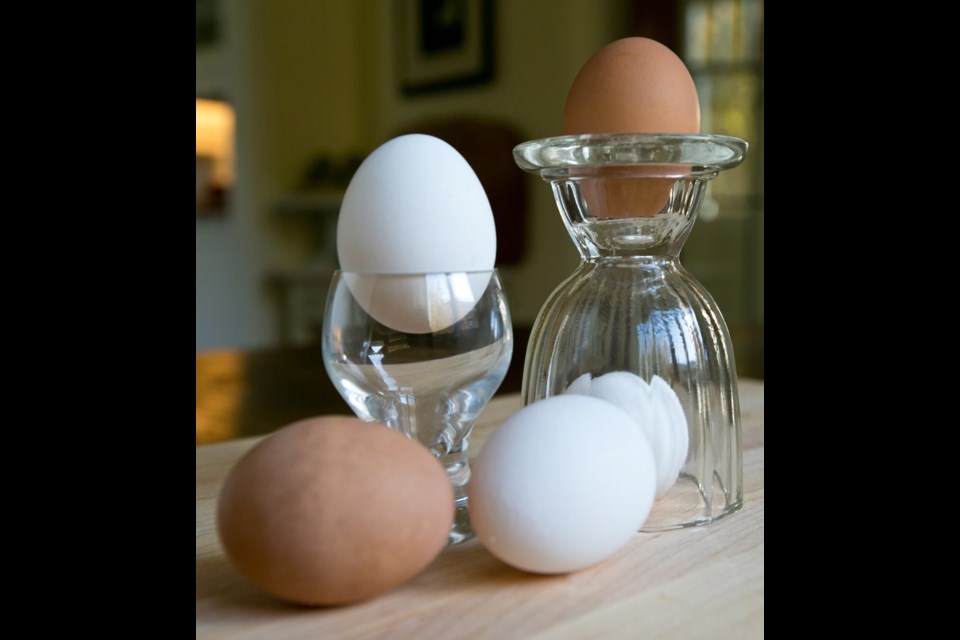 On the list of foods it would be hard to live without, for me, eggs are near the top of the list. Mayonnaise, hollandaise, quiche, fillings, cakes, soufflés, savoury dishes, salads, desserts and, of course, a hearty breakfast, are just some of the tasty creations that would be compromised without them.
On the list of foods it would be hard to live without, for me, eggs are near the top of the list. Mayonnaise, hollandaise, quiche, fillings, cakes, soufflés, savoury dishes, salads, desserts and, of course, a hearty breakfast, are just some of the tasty creations that would be compromised without them.
Luckily eggs are not going anywhere, except from the place you’ve acquired them from to your kitchen. Before you get cracking and try today’s recipes, which you could enjoy during the Christmas season, here are a few things to know about eggs.
Nutritional content: Eggs are relatively low in calories, provide high quality protein, every vitamin except C, and contain iron and other minerals. Brown and white eggs, although different on the outside, are the same when it comes to quality and nutritional content.
Buying and storing: When buying eggs from a grocery store, check the best-before date. Store eggs in your refrigerator. If left at room temperature, they’ll lose quality fairly quickly. Eggshells are porous and can easily absorb odours in your refrigerator. That’s why it’s best to leave eggs in their carton, which is designed to protect them.
Freshness test and another trick: According the Egg Farmers of sa���ʴ�ý website, eggs.ca, Grade A eggs have a firm white, a small air cell at the wide end and a centred yolk.
• If you place an egg in water, a very fresh one will sink, while an older egg will float. Why? As an egg ages, the size of that air cell increases, giving the egg buoyancy when set in water.
• Unpeeled, hard-cooked eggs can look like raw eggs from the outside. If you’ve stored a boiled egg in your refrigerator and can’t tell it apart from your raw eggs, simply spin it. A hard-cooked egg will spin longer than a raw egg.
How to crack an egg: Many folks crack their eggs open by tapping them on the rim of a bowl or pot. This works, but sometimes it can cause small fragments of eggshell to end up in the bowl or pot. That’s why egg-savvy people prefer to crack the eggs on a clean, flat surface, causing the eggs to crack more evenly. To do so, hold the egg in one hand and in one quick motion tap it against the flat surface. Now use your thumbs to open the eggshell where it’s cracked.
Cooking Eggs: When cooking eggs, such as by frying, boiling or poaching, don’t crank up the heat. Instead, cook them in barely simmering water or over medium heat, as the more gentle cooking conditions will yield more tender eggs.
��
Dilled Devilled Eggs with Smoked Salmon and Capers
Deluxe devilled eggs flavoured with dill and accented with silky smoked salmon. The bit of butter in the filling provides added richness and makes the filling pipe beautifully.
Preparation time: 40 minutes
Cooking time: nine minutes
Makes: 24 devilled eggs
��
12 large eggs (see Note)
1/2 cup mayonnaise
2 tsp Dijon mustard
1 Tbsp soft butter
2 tsp chopped fresh dill
• salt to taste
24 thin (about 5-cm long) slivers of smoked salmon
48 capers, patted dry
24 tiny dill sprigs
Place the eggs in a pot and cover them with cold water. Bring to a gentle boil over medium-high heat, where the surface of the water is just moving and small bubbles rise and break on the surface. Adjust the heat as needed to maintain that gentle boil. Set a timer for nine minutes.
After nine minutes, drain the eggs well and fill the pot with ice-cold water. Chill for two to three minutes, until the eggs have cooled but are not icy cold. Tap an egg on the bottom and top of the shell, gently roll between your hands and then peel. Repeat with remaining eggs.
Carefully slice the eggs in half lengthwise. Carefully remove the yolks and place in a bowl. Arrange the egg halves on a platter or two (see Note 2). Mash the yolks until very smooth. Add the mayonnaise, mustard, butter and dill and vigorously whip until the mixture is smooth and light. Season the filling with salt.
Spoon or pipe the filling into the egg halves. Top each with a sliver of smoked salmon and two capers. Chill devilled eggs one hour, until the filling is set. Now tent with plastic wrap and refrigerate until ready to serve.
Devilled eggs can be made a few hours in advance of serving. When ready to serve, garnish each egg with a tiny dill spring and enjoy.
Note 1: You may wish to cook two or three extra eggs, just in case one or more of the eggs don’t peel well or you make a slip when cutting them. The extra eggs yolks will also bulk up the filling.
Note 2: If your platter isn’t the prettiest, you could line it first with shredded head lettuce or baby mixed salad greens before setting on the eggs.
��
One-Pan Breakfast
Make extra boiled potatoes for dinner and save a couple for the next morning. It’s a quick way to cook a substantial breakfast for four people. This recipe is from my hardcover book Everyone Can Cook Everything.
Preparation time: 20 minutes
Cooking time: six to eight minutes
Makes: four servings
��
2 Tbsp butter
1 cup cubed ham
2 medium red potatoes, boiled until tender, cooled and cubed
1Ú4 cup finely chopped red bell pepper
8 large eggs
1Ú4 cup milk or water
1 cup grated cheddar cheese
2 green onions, thinly sliced
• salt and black pepper to taste
Melt butter in a large nonstick skillet over medium-high heat. Add ham, potatoes and bell pepper and cook for three or four minutes, stirring occasionally. Whisk the eggs with the milk until well combined. Stir the cheese, green onions, salt and pepper into the egg mixture and pour into the pan. As the eggs begin to set, gently turn and lift them from the bottom and sides of the skillet, forming large, soft curds.
When the eggs are just set, divide among four plates and serve immediately with toast.
Eric’s options: Halve the recipe if you’re serving two people.
If you like mushrooms, slice half a dozen and add them with the ham, potatoes and pepper. For a meat-free version, omit the ham and add a cupful of another vegetable, such as diced zucchini.
Creamy Four-Spice Eggnog
Some homemade eggnog is made with raw eggs, but if you feel queasy about that, try this recipe. Cooking eggs, milk and sugar into a lightly thickened mixture is how to start preparing it. The heated mixture is then richly enhanced with cream and spices. Once the eggnog is chilled well, you have a divine holiday drink, minus the artificial ingredients added to some store-bought eggnog.
��
Preparation time: 20 minutes
Cooking time: 10 minutes
Makes: About 10 (1 cup) servings
��
6 large eggs
2/3 cup granulated sugar
2 tsp cornstarch
6 1/4 cups 2% or whole milk
2 cups whipping cream
2 tsp pure vanilla extract
1/4 tsp ground or freshly grated nutmeg to taste
1/4 tsp ground cinnamon
1/8 tsp ground cloves
• rum or brandy, to taste (optional)
• cinnamon sticks, for garnish (optional)
Place the eggs, sugar and cornstarch in a large bowl and whisk until the whites and yolks are thoroughly blended.
Place the milk in a heavy-bottomed pot, set over medium heat and bring to just below a simmer, whisking frequently so the milk does not scorch on the bottom. Remove the pot from the heat.
Very, very slowly dribble and whisk half the hot milk into the egg mixture to temper it. Whisk this mixture back into the pot with the remaining hot milk. Place the pot back over medium heat and cook (do not boil), stirring often, until the mixture lightly thickens and registers
165 F on an instant-read thermometer.
Remove eggnog from the heat. Whisk in the whipping cream. Strain the mixture through a fine sieve into a bowl.
Mix in the vanilla, nutmeg, cinnamon and cloves, and then cool eggnog to room temperature. Transfer eggnog to a serving jug, cover and refrigerate until well chilled, at least four hours. The eggnog can be made one or two days in advance of serving.
When ready to serve, give the eggnog a stir. Pour into glasses and enjoy as is, or add a splash of rum or brandy. Garnish each drink with a cinnamon stick, if desired.
Eric Akis is the author of the hardcover book Everyone Can Cook Everything. His columns appear in the Life section Wednesday and Sunday.



